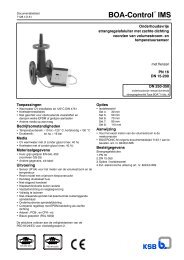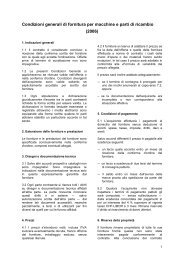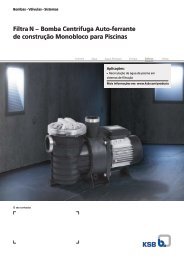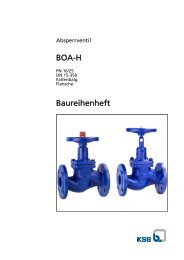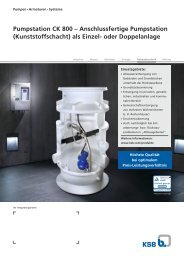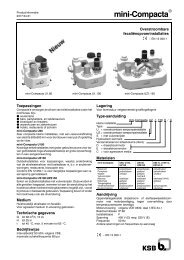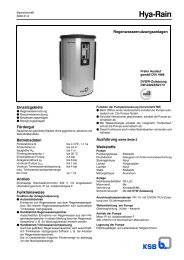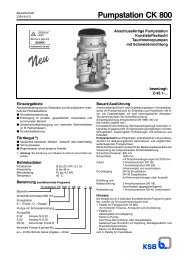BOA-SuperCompact Type Series Booklet
BOA-SuperCompact Type Series Booklet
BOA-SuperCompact Type Series Booklet
Create successful ePaper yourself
Turn your PDF publications into a flip-book with our unique Google optimized e-Paper software.
Globe Valves<br />
Soft-seated Globe Valves<br />
Chemical resistance chart<br />
The information provided in this chemical resistance chart is<br />
based on experience, the Dechema lists as well as<br />
manufacturer information. Corrosion resistance is largely<br />
dependent on the operating conditions, temperatures and<br />
concentrations. Hydroabrasive wear in fluids containing solids<br />
is not covered in this list. All information provided herein,<br />
therefore, only serves as an orientation. Warranty claims may<br />
not be asserted on the basis of this list!<br />
Chemical resistance chart for water 6)<br />
Fluid handled Max. content Max. temp.<br />
Bathing water (fresh water)<br />
○<br />
Bathing water (seawater) ✖<br />
Brackish water ✖<br />
Service water ○<br />
Chlorinated water 0,6 mg/kg ✔<br />
Deionised water<br />
✖<br />
(demineralised water)<br />
Distilled water ✖<br />
Heating water ✔<br />
Condensate ○<br />
Oil-free cooling water ○<br />
Oil-containing cooling<br />
✖<br />
water<br />
Seawater ✖<br />
Ozonised water 0,5 mg/kg ✔<br />
Pure water ✔<br />
Raw water ○<br />
Waste water 7) ✔<br />
Partly desalinated water ○<br />
Thermal water ✖<br />
Drinking water ✖<br />
Fully desalinated water<br />
✖<br />
Chemical resistance chart for other fluids<br />
Fluid handled Max. content Max. temp.<br />
Landfill gas ○<br />
Oil-containing compressed<br />
✖<br />
air<br />
Aqueous glycerine ○<br />
Carbon dioxide (gas) ✔<br />
Carbon dioxide<br />
✖<br />
(aqueous solution)<br />
Oxygen O₂ ✖<br />
Key to the symbols<br />
Symbol<br />
✔<br />
✖<br />
○<br />
Description<br />
The fluid handled is not normally aggressive toward<br />
the materials. Valve can be used if 6) and 7) are<br />
observed.<br />
The fluid handled is aggressive toward the<br />
materials. Valve cannot be used.<br />
The material or valve can only be used under certain<br />
operating conditions. Please enquire accordingly<br />
stating the operating conditions such as<br />
concentration, temperature, pH value and<br />
composition of the fluid handled.<br />
Chemical resistance chart for oils (aromatic content 5 mg/kg)<br />
Fluid handled Max. content Max. temp.<br />
Vegetable oils ✖<br />
Mineral oils ✖<br />
Synthetic oils ✖<br />
Petroleum ✖<br />
Oil-water emulsion ✖<br />
Kerosene ✖<br />
Chemical resistance chart for refrigerants<br />
Fluid handled Max. content Max. temp.<br />
Ammonium hydroxide 25 % 25 °C ✔<br />
Glycol (ethylene glycol) ✔<br />
Water-glycol mixture 50 % 90 °C ✔<br />
Inorganic cooling brine,<br />
ph 7,5 inhibited<br />
✔<br />
Chemical resistance chart for cleaning agents<br />
Fluid handled Max. content Max. temp.<br />
Lye for bottle rinsers (e.g.<br />
P3)<br />
Lye for<br />
metal cleaning<br />
✔<br />
✖<br />
6) General criteria for water to be handled by valves made of non-alloyed materials: pH value 6,5 - 12; chlorides (Cl-)<br />
< 150 mg/kg; chlorine (Cl) < 0,6 mg/kg. Other factors to be considered: hardness, carbon dioxide content (CO₂), oxygen (O₂)<br />
and dissolved substances. Contact KSB if limits are exceeded!<br />
7) Without larger solids or stringy material<br />
<strong>BOA</strong>-<strong>SuperCompact</strong> 9



